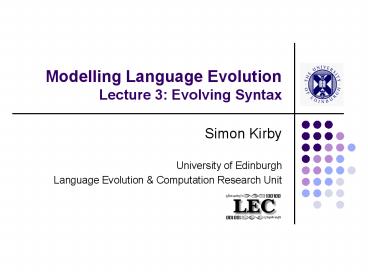Modelling Language Evolution Lecture 3: Evolving Syntax - PowerPoint PPT Presentation
Title:
Modelling Language Evolution Lecture 3: Evolving Syntax
Description:
The top third have their weights reset to what their genes specify ... Initial weights are a different type of innateness than Elman's. ... – PowerPoint PPT presentation
Number of Views:44
Avg rating:3.0/5.0
Title: Modelling Language Evolution Lecture 3: Evolving Syntax
1
Modelling Language EvolutionLecture 3 Evolving
Syntax
- Simon Kirby
- University of Edinburgh
- Language Evolution Computation Research Unit
2
Evolving the ability to learn syntax (Batali 1994)
- A standard recurrent network does not seem to
be able to learn syntax without some help - Elman provides this help via incremental memory
- The network comes pre-setup to help it learn
syntax - i.e., our model of an individual is born with a
working memory that grows over time - Does this correspond to an innate
prespecification for language learning?
3
Where do innate abilities come from?
- If an organism has some innate predisposition
- and that predisposition is functional, how do
we explain it? - Darwinian natural selection seems appropriate.
- Could we model natural selection?
- Can we evolve a syntax learner? (as opposed to
building one by hand?)
4
What things about a network could be innate?
- Many features of networks could be thought of as
innately determined - The length of time before context units are
blanked - The shape of the activation function
- The number of nodes in the hidden layer
- Batali suggests the initial connection weights.
- Normally, these are random but what if they
were specified by genes?
5
How to model an organism
0.2 -1.3 0.05 0.9 -0.5 0.001 0.1
GENOTYPE
development
PHENOTYPE
- The model has genes, which are expressed as a
phenotype. - The phenotype is simply the initial state of a
network (before learning).
6
How to evolve organisms
- Crucial aspects of evolution
- A population of organisms (with varying
phenotypes) - A task which they are trying to succeed at
- A measure of how fit they are at this task
- A way of selecting the fittest
- A way of allowing the genes of the fittest to
survive - A mechanism for introducing variation into the
gene pool - Various techniques to model all of this (i.e.,
Genetic Algorithms, Artificial Life etc.)
7
Batalis model of evolution
- Each organism (or agent) has its weights set by
genes - The agents then trained on some language
- The agents error is used to assign fitness
- Only the top third of the population is kept
- The top third have their weights reset to what
their genes specify - Each agent gives birth to two new agents with
approximately the same genes (i.e., genes are
mutated) - Go to step 1.
8
The language task
- One of the simplest languages that involves
embedding is - ab
- aabb
- aaaaaaaabbbbbbbb
- aaaaaaaaabbbbbbbb
- What machinery would you need to recognise
strings from this language? - Minimally a simple counter
- Can an SRN with random initial weights learn this
language?
9
Performance of a trained (but non-evolved) net
- Networks fail to learn to count (although some
aspects of the language are learnt).
10
Evolving a better network
- Batali used a population of 24 nets (initially
with genes specifying random weights) - Evolved using a fitness function based on
abilityat after training - After 150 generations, the networks were better
at learning the task - They evolved initial weight settings that made
learning syntax possible
11
Evolved network performance
a
b
sp
rec
12
(No Transcript)
13
Issues that remain
- What is learning doing?
- If language is always the same, the networks
could eventually end up with the whole thing
innate (and not need learning at all!) - What would happen if the networks were trained on
a class of languages? - Initial weights are a different type of
innateness than Elmans. Can Batali also explain
the critical period?
14
Is evolution just the same as learning?
- We can think of a fitness landscape just like an
error surface - What are the differences?
- Does evolution do gradient descent?































